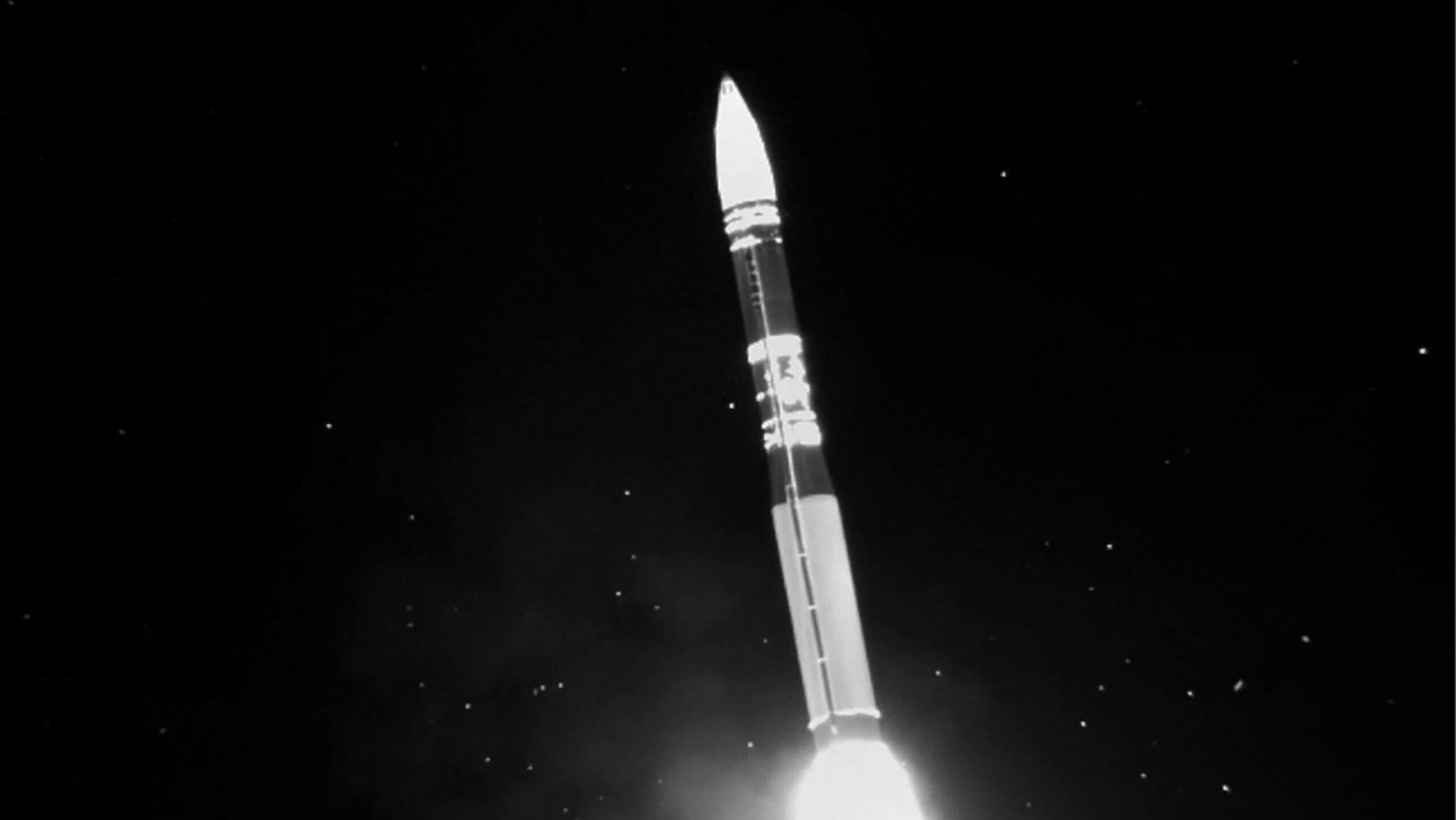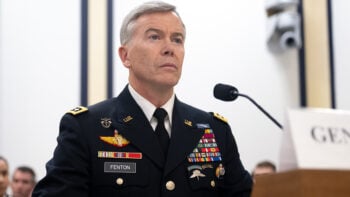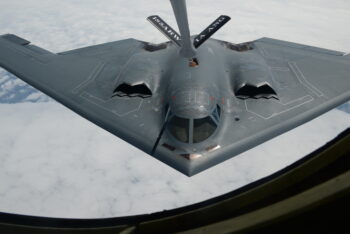
An Air Force Global Strike Command unarmed Minuteman III intercontinental ballistic missile launches during an operational test at Vandenberg Air Force Base, Calif., Sept. 2, 2020. (U.S. Air Force photo by Vandenberg Air Force Base Public Affairs)
After months of study, the Air Force may (or may not) be on the verge of a major restructuring. While a shakeup has yet to be confirmed — much less the details of the plan — in this op-ed nuclear policy experts Adam Lowther and Curtis McGiffin examine one road that they say Air Force Secretary Frank Kendall should definitely not follow.
During the Space Force Association’s annual conference in mid-December, Lt. Gen. Michael Guetlein, the commander of Space Systems Command, raised eyebrows when he said, “The Air Force is going to get rid of the major command structure.” He added, “Think about how fundamental that is to the way we fight today and the way we’ve always thought about the Air Force. And we’re going to step away from what we know as the MAJCOM structure. That’s going to be a huge change.”
He later retracted his comments and explained that no concrete decisions was made … yet. For a careful officer like Guetlein to speak publicly of such radical change, the decision is likely not far from concrete, however.
Guetlein’s comments should come as no surprise. It was Secretary of the Air Force Frank Kendall, who, on Sept. 11, 2023, at the Air Force Association (AFA) annual conference, announced that he would launch a “sweeping” review of Air Force readiness and “reoptimize” the service for combat. Kendall said recommendations would come in January 2024.
RELATED: ‘Huge change’ afoot? Air Force apparently weighing major command structure revamp
The words of Kendall and Guetlein should cause great concern because the idea that the Air Force is not properly organized is an old trope bandied around since the Air Force was reorganized after the Cold War. During the conflicts in Afghanistan and Iraq, there was significant discussion among senior Air Force officers that it was the US Army that was structured properly and better able to present forces in a way that did not break the service — as nearly happened to the Air Force.
Thus, it would come as no surprise if the Air Force is planning a massive reorganization, it could pursue a structure like the US Army. However, eliminating the Air Force’s major commands, or consolidating them into three major commands, is an unequivocal mistake. That mistake is most pronounced in the impact on the Air Force’s nuclear forces—the bomber and intercontinental ballistic missile (ICBM) legs of the nuclear triad. Let us explain.
The Army has four major commands: Army Future Command, Army Materiel Command, Army Forces Command, and Army Training and Doctrine Command. If the Air Force were to adopt a similar structure, Air Combat Command (ACC), Air Force Global Strike Command (AFGSC), Air Force Special Operations Command (AFSOC) maybe, and Air Mobility Command (AMC) would all be consolidated into Air Force Forces Command. Air Education and Training Command and Air Force Materiel Command would look the same.
An Air Force Forces Command that consolidates its “combat forces,” would necessarily focus on conventional warfighting and neglect its nuclear mission. When nuclear forces become part of a command focused on conventional warfighting, the nuclear mission is overlooked, and consequential errors are made. A quick look at Air Force history provides useful examples.
When Strategic Air Command (SAC) was created in 1946, it quickly became both an Air Force major command and a specified combatant command. This meant that SAC performed the functions of an Air Force major command (organize, train, and equip forces) and served as the combatant command responsible for waging war, including nuclear deterrence.
When Strategic Air Command was disestablished in 1992, the forces performing the nuclear mission were broken apart and spread across five different Air Force major commands. Thus, in 1992, the organize, train, and equip responsibilities for the nuclear bomber force, ICBM force, and aerial tanker force, and its support elements fell to major commands responsible for tactical fighters (ACC) and airlift/transportation (AMC). Neither had any experience or interest in managing nuclear operations.
After a year in ACC, the ICBM fleet was reassigned to Air Force Space Command. For 15 years (1993–2009), developing expertise in nuclear operations became secondary for missileers to learning space operations. The saying went, “If you ain’t in space, you ain’t in the race.” The only way a missileer could be promoted to senior ranks was through jobs in space operations—not nuclear operations. Furthermore, B-52 units assigned to ACC had not conducted no-notice nuclear surety inspections in 15 years.
The loss of focus within the nuclear mission led to a widespread cultural decline across the nuclear force. It should come as no surprise that after 15 years of the Air Force taking its eye off the ball, nuclear weapons were inadvertently flown from Minot to Barksdale Air Force Base in August 2007. This, and other incidents, resulted in then-Secretary of Defense Robert Gates firing his Secretary of the Air Force and Chief of Staff in 2008.
Under pressure, the Air Force created Air Force Global Strike Command in 2009 and realigned nuclear forces under one major command—dedicated to the nuclear mission.
It took the Air Force 15 years to learn some hard lessons, and it is now 15 years since those lessons were learned. It appears the Air Force is ready to forget them.
The nuclear mission is different from any other in the Air Force. Because of this, SAC had a unique culture found nowhere else. The expectation of perfection was necessary because a failure could have catastrophic consequences.
Disestablishing Air Force Global Strike Command and subsuming ICBMs, nuclear bombers, and the nuclear command, control, and communications mission within an Air Force Forces Command would be shortsighted. Such a decision would return the nation to a time when the Air Force focused on everything but the nuclear mission. This would all occur at a time when nuclear deterrence is increasingly important.
There is a widespread misperception that change is good. Reorganizing the Air Force is one example. Airmen across the service realize that it is not the Air Force’s organization that is its problem. The major commands are already functionally aligned to the geographic or functional combatant command they support.
Too often reorganization is a substitute for good leadership. Thus, should Kendall step onto the stage at AFA in September and announce yet another major shakeup of the Air Force, it may be a move the Air Force comes to regret.
Adam Lowther is Vice President for Research at the National Institute for Deterrence Studies and host of the Nuclecast podcast. Col. Curtis McGiffin (U.S. Air Force, Ret.) is Vice President for Education at the National Institute for Deterrence Studies and visiting professor at Missouri State University’s School of Defense and Strategic Studies. Together, they have more than five decades of experience in uniform and DoD civil service serving America’s nuclear enterprise.
Elbit’s new Red Sky air defense system goes public with first customer
The system includes a radar, as well as links to a 30mm gun and missile system for downing threats within ranges of seven kilometers and 15,000 feet, according to a company executive.


























